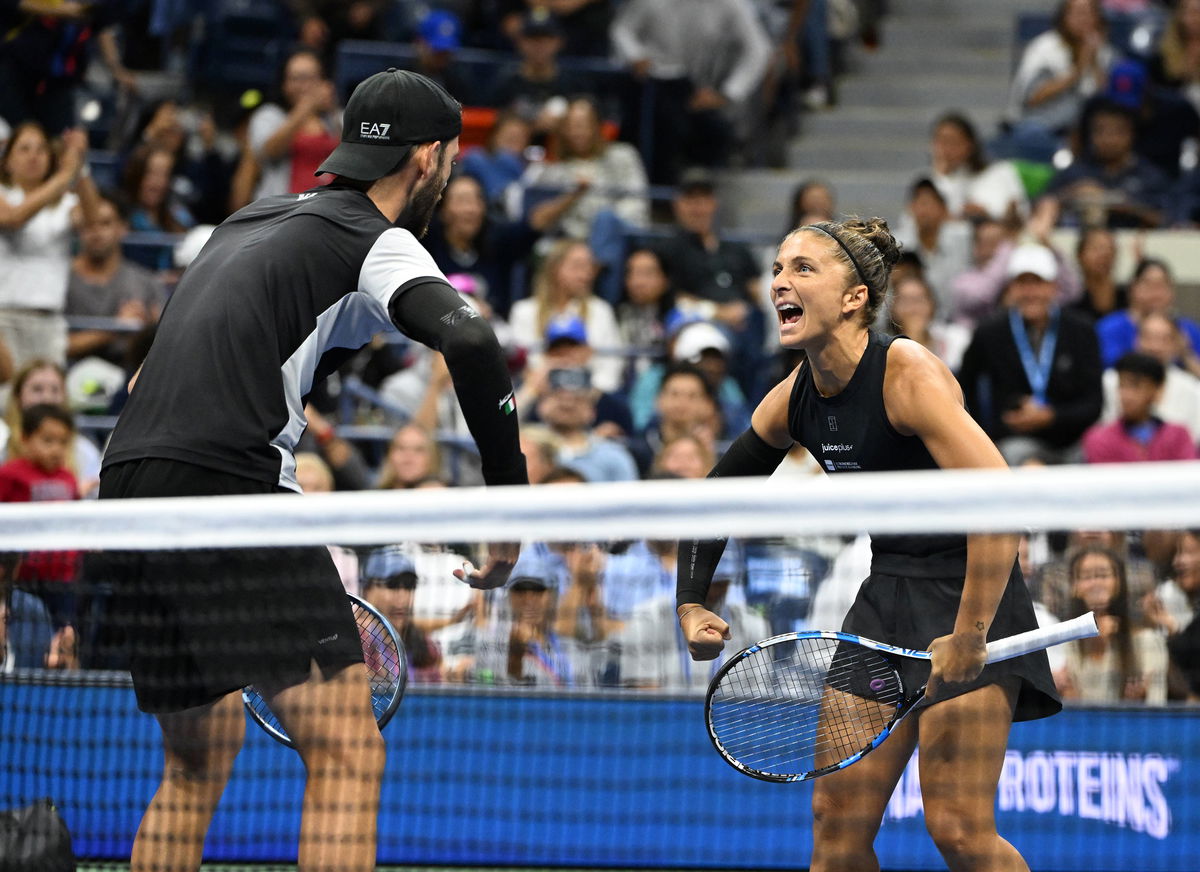
Imago
Sara Errani and Andrea Vavassori react after defeating Danielle Collins and Christian Harrison during the Mixed Doubles Semi Finals on Arthur Ashe Stadium at the 2025 US Open Tennis Championship at the USTA Billie Jean King National Tennis Center in New York City on Wednesday, August 20, 2025 in New York City. Sara Errani and Andrea Vavassori react after defeating Danielle Collins and Christian Harrison 4-2-4-2 and advance to the finals. PUBLICATIONxINxGERxSUIxAUTxHUNxONLY NYP20250820516 LarryxMarano

Imago
Sara Errani and Andrea Vavassori react after defeating Danielle Collins and Christian Harrison during the Mixed Doubles Semi Finals on Arthur Ashe Stadium at the 2025 US Open Tennis Championship at the USTA Billie Jean King National Tennis Center in New York City on Wednesday, August 20, 2025 in New York City. Sara Errani and Andrea Vavassori react after defeating Danielle Collins and Christian Harrison 4-2-4-2 and advance to the finals. PUBLICATIONxINxGERxSUIxAUTxHUNxONLY NYP20250820516 LarryxMarano
The USTA wanted spectacle. They got the spectacle, but they also got embarrassment. At the 2025 US Open, the governing body of American tennis, the United States Tennis Association (USTA), scrapped tradition and changed the mixed doubles entry system to spotlight singles stars. Their logic was simple: big names drive bigger ratings. Instead of awarding spots based on doubles rankings as in past years, eight of the 16 teams were determined by combined singles rankings, and the other eight through wildcards. The fallout? Out of the entire field, only one true doubles team, Italians Sara Errani and Andrea Vavassori, made it in.
Watch What’s Trending Now!
That lone pair went on to prove exactly why the decision backfired. Errani and Vavassori, specialists who live and breathe doubles, not only survived the condensed two-day schedule but defended their crown in emphatic style. They capped their fourth win in less than 48 hours by beating world No. 1 Iga Swiatek and Casper Ruud 6–3, 5–7, 10–6. The irony couldn’t have been sharper: the only true doubles team was also the last one standing . And the reaction was immediate.
Former Georgia standout Jan Zielinski celebrated the victory after the US Open final with a pointed post: “Doubles on TOP! Statement made! Forza Italia!” But he didn’t stop there, adding, “How about allowing more doubles specialists next time to spice it up? Let’s not make it too easy for Vava and Sara!” His words captured what many inside tennis were already saying: the USTA’s experiment sidelined the very players who give the discipline its identity. That shift was stark. Normally, doubles specialists anchor mixed doubles fields. This year, they were virtually erased. Katerina Siniakova, a former world No. 1 in doubles and two-time Olympic gold medalist, applied for a wildcard but wasn’t granted one. She was partnered up with Jannik Sinner only because Sinner’s original partner, Emma Navarro, withdrew. But with Sinner pulling out himself due to illness, Siniakova was left in the lurch and had to miss the tournament entirely.
ADVERTISEMENT
Doubles on TOP!
Statement made!
Forza Italia! 🇮🇹@SaraErrani Andrea VavassoriHow about allowing more doubles specialists next time to spice it up? Let’s not make it too easy for Vava and Sara! @usopen @ebutorac pic.twitter.com/6P2L1rYXps
— Jan Zielinski (@zielaczekk) August 21, 2025
The elements the USTA will call a success? Viewership, spectacle, and of course, money. The champions’ prize jumped to $1 million, up $800,000 from 2024, part of the push to raise the profile of mixed doubles. But prestige cannot paper over perception. By excluding almost every doubles specialist and then watching the only true team win it all, the USTA may have made the best argument yet for restoring balance. And when the dust settled, the champions themselves didn’t shy away from sharing exactly how they felt about it.
ADVERTISEMENT
Is US Open rule a Grand Slam or just a marketing stunt?
The Italian duo came into US open with more than just another trophy in mind. They were fighting for doubles itself. Written off as underdogs in their opening clash with Taylor Fritz and Elena Rybakina, Sara Errani and Andrea Vavassori stormed through in straight sets and never looked back.
After one victory, Vavassori made it clear what was at stake. “Tactics in doubles are very important,” he told the crowd. “There are many very strong players here, but we often play together, we also talk off the court, and this is important. We also play for all the doubles players who cannot compete at the mixed doubles tournament here. We try to do our best.”
ADVERTISEMENT
That sentiment echoed far beyond the court. Errani and Vavassori denounced the new entry rules as a “profound injustice,” and prominent voices in tennis lined up behind them. Kristina Mladenovic, a former World No. 1 in doubles and nine-time Grand Slam champion, blasted the event’s legitimacy: “A Grand Slam is neither preparation nor fun. It’s years of sacrifice. When you’re young, you dream of winning one, even in doubles.”
Her comments were a direct rebuke to the singles players, like Jack Draper, who had described the revamped mixed doubles as an “exhibition” after pairing with Jessica Pegula. For Mladenovic, and for many in the doubles community, the USTA’s experiment crossed a line, turning what should be a crown jewel into what she saw as a marketing stunt.
ADVERTISEMENT
ADVERTISEMENT
ADVERTISEMENT

